Dermatoscopy / Mole Mapping
Seborrheic dermatitis is a common, recurrent, non-contagious condition of the skin and scalp, which manifests itself in areas with overactive sebaceous glands.

01. History & examination
We begin by taking a history from the patient and examining for uniformity or inhomogeneity.

02. Treatment & management
We prioritize modern therapeutic methods based on our patient's choices and desires.

03. Emphasis on the result
We are by your side at every stage to help you with personalized treatments to have healthy and beautiful skin.

Your skin health is our priority
The symptoms
In adults, this chronic skin inflammation appears as indeterminate red plaques covered with small sticky scales, mainly in areas where the skin is rich in sebum such as the sides of the nose, eyebrows, forehead or at the hairline as sticky flakes. Often, these symptoms are accompanied by dandruff on the scalp with an intense itching sensation.
In babies, this condition takes the form of the well-known "ringworm" on the face and scalp. The symptoms are similar to those in adults (redness, itching, and thick yellow or brown flakes) but their distribution differs, as it is mainly located on the scalp. However, it can also occur on the ears, eyelids, eyebrows, nose, neck, or armpits.
The causes
According to experts, the causes that trigger the appearance of seborrheic dermatitis are many, including:
- Excessive sebum production in the skin and scalp, which favors the overgrowth of the Malassezia fungus present on the skin, which causes inflammation and is responsible for the appearance of the condition.
- The presence of large amounts of sebum in certain areas of the skin favors the development of seborrheic dermatitis. The condition worsens when the body's immune system is weakened.
- Stress
- The cold, dry weather
- Harsh cleaning product formulations
- The hereditary predisposition
- The weakened immune system
- Specific diseases or medications
Treatment
Treatment of seborrheic dermatitis often includes several of the following options:
- Keratolytics to remove scales when necessary
- Antifungal agents that reduce yeast
- Mild topical corticosteroids to reduce inflammation in acute flare-ups
- Calcineurin inhibitors
In resistant cases in adults, oral itraconazole, antibiotics, or phototherapy may be recommended. In these contexts, control of exacerbation factors such as stress always plays a special role.
The Result of Our Work
by experienced masters of our clinic.
Frequently asked questions
Contact us
We are here for you for any questions or problems you may have! We will be happy to serve you!

Phone:
2441 025155

Address:
14 Vassiardani, Karditsa

E-mail:
info@makrisderma.gr
Online Appointment
